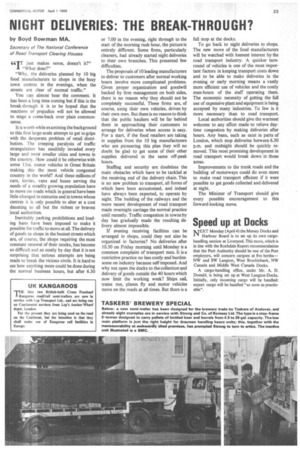NIGHT DELIVERIES: THE BREAK-THROUGH?
Page 25

If you've noticed an error in this article please click here to report it so we can fix it.
by Boyd Bowman MA,
Secretary of The National Conference of Road Transport Clearing Houses
C4TT just makes sense, doesn't it?" 1"What does?"
"Why, the deliveries planned by 10 big food manufacturers to shops in the busy town centres in the evenings, when the streets are clear of normal traffic."
You can almost hear the comment. It has been a long time coming but if this is the break-through it is to be hoped that the reactions of prejudice will not be allowed to stage a come-back over plain commonsense.
It is worth while examining the background to this first large-scale attempt to get to grips with the desperate problem of retail distribution. The creeping paralysis of traffic strangulation has stealthily invaded every large and most smaller cities and towns in the country. How could it be otherwise with some 13m. motor vehicles in Great Britain making this the most vehicle congested country in the world? And these millions of cars, lorries, vans and buses serving the needs of a steadily growing population have to move on roads which in general have been little changed in centuries and in towns whose centres it is only possible to alter at a cost daunting to all but the richest or bravest ,local authorities.
Inevitably parking prohibitions and loading bans have been imposed to make it possible for traffic to move at all. The delivery of goods to shops in the busiest streets which are, of course, the shops requiring the most constant renewal of their stocks, has become so difficult and so costly by day that it is not surprising that serious attempts are being made to break the vicious circle. It is hard to see how anything more could be done during the normal business hours, but after 6.30 or 7.00 in the evening, right through to the start of the morning rush hour, the picture is entirely different. Some firms, particularly cleaners, had already started night deliveries to their own branches. This presented few difficulties.
The proposals of 10 leading manufacturers to deliver to customers after normal working hours involve more complicated problems. Given proper organization and goodwill backed by firm management on both sides, there is no reason why they should not be completely successful. These firms are, of course, using their own vehicles, driven by their own men. But there is no reason to think that the public hauliers will be far behind them in approaching their customers to arrange for deliveries when access is easy. For a start, if the food retailers are taking in supplies from the 10 big manufacturers who are pioneering this plan they will no doubt be glad to get some of their other supplies delivered in the same off-peak hours.
Staffing and security are doubtless the main obstacles which have to be tackled at the receiving end of the delivery chain. This is no new problem to transport, all forms of which have been accustomed, and indeed have always been expected, to operate by night. The building of the railways and the more recent development of road transport made overnight carriage the normal practice until recently. Traffic congestion in towns by day has gradually made the resulting delivery almost impossible.
If evening receiving facilities can be arranged in shops, could they not also be organized in factories? No deliveries after 10.30 on Friday morning until Monday is a common complaint of transport men. It is a restrictive practice no less costly and burdensome on industry because self-imposed. And why not open the docks to the collection and delivery of goods outside the 40 hours which now limit the working week? Ships sail, trains run, planes fly and motor vehicles move on the roads at all times. But there is a full stop at the docks.
To go back to night deliveries to shops. The new move of the food manufacturers will be watched with keenest interest by the road transport industry. A quicker turnround of vehicles is one of the most important factors in keeping transport costs down and to be able to make deliveries in the evening or early morning means a vastly more efficient use of vehicles and the costly man-hours of the staff operating them. The economic necessity of getting the full use of expensive plant and equipment is being accepted by many industries. To few is it more necessary than to road transport.
Local authorities should give the warmest welcome to any effort made to relieve daytime congestion by making deliveries after hours. Any bans, such as exist in parts of London, which stop deliveries between 6.30 p.m. and midnight should be quickly removed. This most promising development in road transport would break down in those areas.
Improvements to the trunk roads and the building of motorways could do even more to make road transport efficient if it were possible to get goods collected and delivered at night.
The Minister of Transport should give every possible encouragement to this forward-looking move.




















































































































